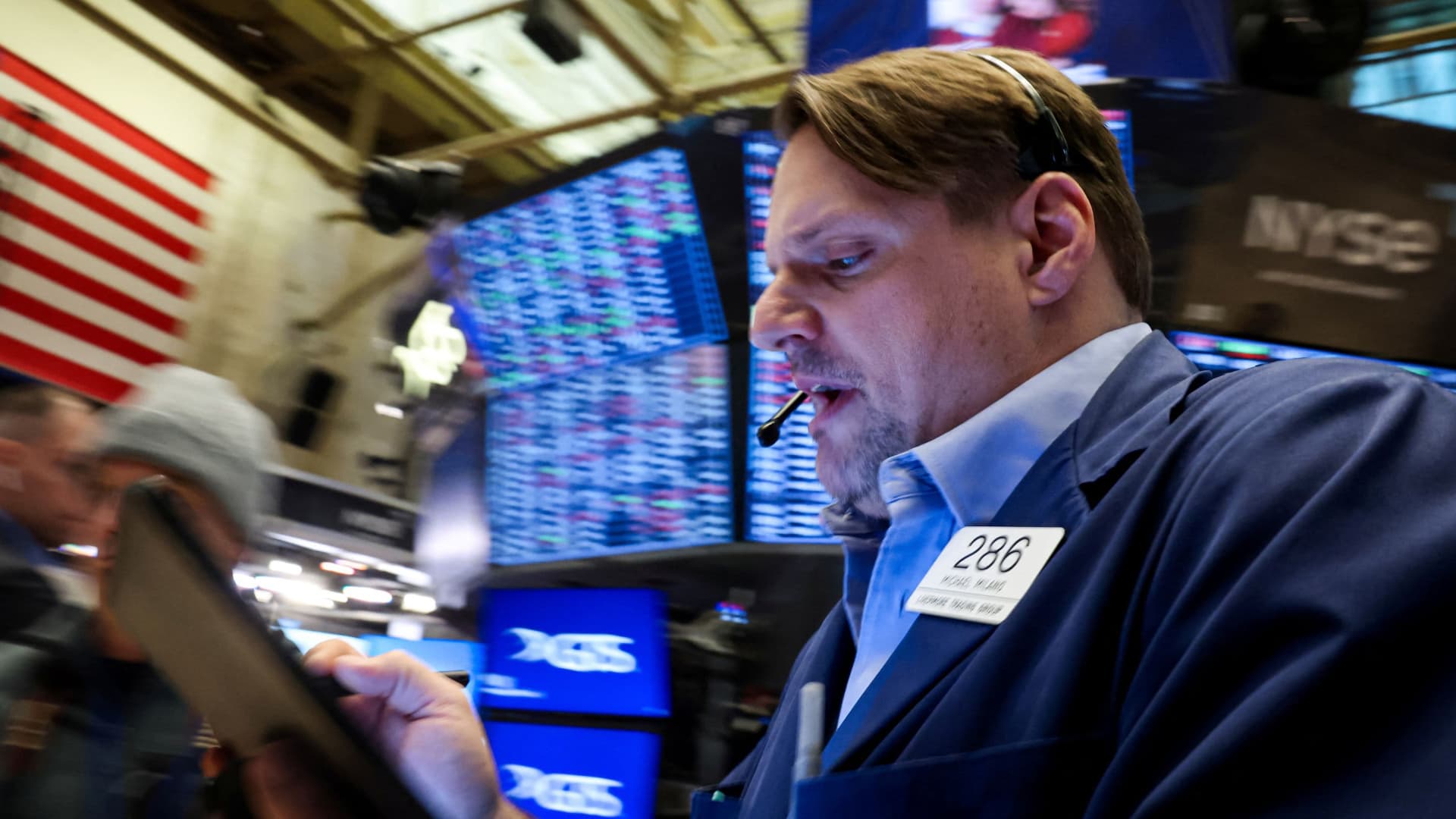A new movie due out next month called “Novocaine” is about a guy unable to feel pain. This is a kind of superpower, right up to the point where it becomes a keen danger, leaving him insensitive to damaging injury. The stock market, similarly, was for weeks calm and unflinching against potential sources of hurt, until on Friday the indexes recoiled under the cumulative pressure of a slow-motion economic-growth scare, against a noisy backdrop of policy flux. Prior to the shaky action Thursday and Friday, the market had been in “immaculate rotation” mode, a deeply split tape passing the baton from sector to sector, growth to value and back, mostly in stride. Buyers showed just enough exertion Tuesday and Wednesday to lift the S & P 500 a quarter of a percent to a marginal new record high each session. This qualifies as resilience, though of an equivocal sort. Warren Pies, co-founder of 3Fourteen Research, notes that the index logged a new record with only 5.5% of its members hitting a 52-week high, less than half the average on past days of a fresh S & P 500 high. .SPX 1Y mountain S & P 500, 1-year This isn’t an odds-on sign of deep trouble to come, but such behavior has meant a less-emphatic signal of good future returns, while making the market a bit more accident-prone. I noted on CNBC Thursday that the market was like a team with a great record in very close games. Many fans view this as a mark of a great team. Yet, in fact, the best teams simply play fewer close games thanks to their dominance. (Apologies for the harsh reminder, Chiefs fans.) Scott Chronert, U.S. equity strategist at Citi, captured the vibe entering Friday: “Higher rates, lesser Fed cuts, DeepSeek, tariffs, and softer guidance despite impressive Q4 results all could have weighed more substantially on headline indices. Instead, we continue to trade near 25x trailing earnings, the index remains fully valued per our [discounted cash flow] work, and it has posted a total return of 3.8% year-to-date through yesterday’s close. While 2025 upside is a far cry from back-to-back 20%+ years, it is still nothing to scoff at. Breaking strong sentiment will take more than that.” ‘Growth scare’ Whether this steadfast investor risk tolerance was buckled by Friday’s 1.7% tumble in the index — driven by consumer and industrial cyclical stocks and accompanied by a squeeze lower in Treasury yields – is next week’s business. The setback was a function of a pileup of factors, as most pullbacks are. Friday’s sour University of Michigan consumer sentiment reading showed decidedly downbeat expectations for household finances in coming years and a pop in inflation expectations. While unwelcome, this might have been dismissed as a fickle and politically inflected data series had it not been preceded by Walmart’s cautious first-quarter guidance, the shortfall in January retail sales, a soft services-sector gauge and rollovers in some travel-and-dining stocks. No one is plausibly inferring a high risk of imminent U.S. downturn from all this, but it complicates the “no economic landing plus policy accelerants” belief that prevailed around the turn of the year. A soft patch or stutter-step in the pace of activity, perhaps, with the cacophonous proposals for Federal layoffs, promised tariffs and threatened spending cuts implying a front-loading of fiscal restraint before any potential deregulatory and tax tailwinds kick in. What we can say for sure is that the S & P 500 has slouched back to levels first reached in early December. And the one-time beacons of the cyclical-acceleration “Trump trade” – industrials, bank stocks and small caps – have all retreated back into, or below, the gap left by their ferocious Nov. 6 rally, the day after the election. A reset in prices and a rethink of certain assumptions, at minimum. But not a refutation of the broader bull case just yet. Tough seasonality ahead Pies, of 3Fourteen, has been on watch for a “growth scare” since the start of the year. Not a recession or the end of the bull market, but a stingier phase susceptible to bouts of unease and downside tests. On Thursday he published an update to his 2025 call, saying that “our caution around the collision of negative seasonality, a looming tax drain, weak spring housing data, and a dicey March Fed meeting is not obviated by the new highs the S & P made this week.” The negative seasonality refers to a less-friendly historical pattern starting the second half of February, something Goldman Sachs’ institutional-equity trading-flow guru Scott Rubner has cited as one reason to place his tactical bullish stance on pause and go “on the lookout for an equity market correction.” Of course, seasonal effects are background conditions and not predetermined outcomes, with plenty of mismatches between the historical record and actual market action, a few as recently as last year. Seasonal weakness is less a reason to flee from risk than an input to setting realistic expectations for the path ahead. Rubner also point out the tenacious bid from retail traders has begun to tire, something no doubt exacerbated by the sharp reversal in several high-momentum cult favorites among smaller investors. Palantir was pole-axed for a 15% loss last week, Robinhood slid 20% and Tesla is in a 30% drawdown that started two months ago. Bitcoin has failed to play ball by joining the Nasdaq at a new high last week. Broadly speaking, investor sentiment is tough to characterize. Strategas Research notes that the recent pace of equity ETF inflows has run above the 90 th percentile of historical readings and put-call ratios show plenty of upside wagering. The below chart of margin debt from Ned Davis Research shows that growth in investor borrowing is near but not above the threshold that has often meant excessive speculation and market-top potential. Yet survey-based investor attitudes, likely more swayed by headlines of lurching policy gambits, are far more subdued. The AAII investor poll for two weeks has reflected an unusual level of bearishness given the market is near a record high. The late-week turbulence probably spread more healthy skepticism and at least got a start on draining some of the pools of froth that had gathered in some parts of the market. Friday sell-offs The week ended with the fifth straight Friday since the inauguration that the S & P 500 was lower. Coincidence or not, this feeds into a story of pre-weekend apprehension about the unknown next moves from a new administration rushing to dismantle parts of government, threaten allies with tariffs and scramble military alliances. The market has been properly disciplined so far in discounting policy impacts in particular, directly relevant pockets rather than market wide. Even with all those down Fridays, the S & P 500 is up 2.4% for the year and is a mere 2% off its peak. Earnings have come in at the requisite beat rates versus forecasts (better than 75%), even as guidance has been cautious on balance. Credit markets have not sent up any panic flares. A shakeout like Friday’s, which pulled the index right to its 50-day moving average, is no dire warning on most timelines in the market multiverse. And for a market trying to navigate the roiling wave action caused by high expectations and elevated valuations interacting with a wait-and-see Fed and a newly hesitant consumer, it’s all still pretty routine for now, even if not entirely painless.
Investment strategy,Markets,Breaking News: Markets,Economic events,Palantir Technologies Inc,Robinhood Markets Inc,Tesla Inc,regwall-pro,business news
#Resilient #stock #market #finally #succumbs #pressure #economic #worries #Trump #policy #flux



